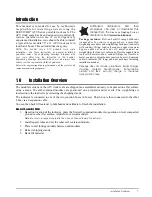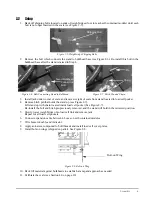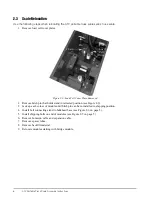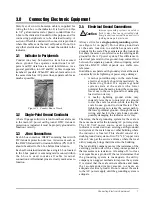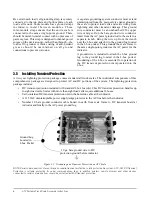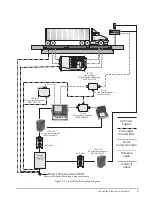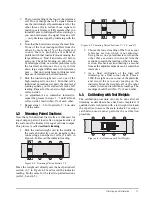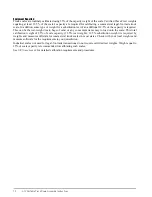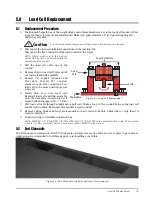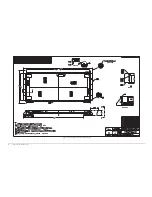
Trimming and Calibration
11
3. The lowest reading of the four is the reference
cell. Do not change that cell’s signal. Instead
use the individual cell potentiometers for the
other three cells to reduce those signals to
match your reference cell. Remember that you
turned all pots to full signal before starting, so
you can not increase the signal from any cell
— only decrease signal by trimming with the
pots.
4. Note that the best trim is always the least trim.
If one of the four readings differs from the
others by more than 5% of the displayed
counts, there is probably a mechanical
problem with that load cell mount causing the
large difference. Find it and correct it before
going on. Check for binding, an out-of-level
or misaligned link, or similar problems with
the load cell and mount.
Do not
try to trim
down large signal differences with resistance
pots — that only adds larger problems later
because of interaction between mounts.
5. Park the loaded weight cart over one of the
high-reading cells on side 1. Turn that cell’s
individual potentiometer until the displayed
reading equals your recorded reference cell
reading. Repeat for the other two high-reading
cells on side 1.
6. As adjustments are somewhat interactive,
repeat the process in steps 1 – 5 until all four
cells on side 1 read within .1% of each other.
7. Repeat steps 1 – 6 for load cells 5 – 8 on side
2 of the scale.
4.3
Trimming Paired Sections
Now that all individual load cells are trimmed for
equal output, pairs of load cells on opposite sides of
the scale must be trimmed for equal sectional output.
This process is called
section trimming
.
1. Park the loaded weight cart in the middle of
the scale and directly over an imaginary line
connecting an end pair of cells (1 and 8 in
Figure 4-4). Record the indicator reading.
Figure 4-4. Trimming Paired Section 1:8
Move the weight cart directly over the next paired cell
section (2, 7 in Figure 4-5) and record the indicator
reading. Do the same for the last two paired sections
(cells 3, 6 and 4, 5)
.
Figure 4-5. Trimming Paired Sections 2:7, 3:6, and 4:5
2. Choose the lowest reading of the four as your
reference section, which is not adjusted.
Using the
section
potentiometers, reload the
other three sections in turn and trim the
sections to match the reading of the reference
section. Recheck section readings a second
time as the adjustment made can be somewhat
interactive.
3. As a final verification of the load cell
trimming, do a final corner check. Place a
1000 lb weight on one corner of the platform
and record the raw-count reading on the
indicator. Move the weight to all of the other
corners in turn and record those readings. The
readings should be within .1% of each other.
4.4
Calibrating with Test Weights
The calibration procedure can only be done after all
trimming as described above has been completed. A
qualified scale technician with a test weight truck and
the expertise to access the scale indicator’s setup or
calibration mode must perform the calibration
procedure.
Figure 4-6. Calibration with Test Weights
1
4
3
2
8
5
6
7
1
4
3
2
8
5
6
7
1
4
3
2
8
5
6
7
Summary of Contents for SURVIVOR ATV series
Page 1: ...ATV Portable Truck Scale Assembly Instructions 68982...
Page 2: ......
Page 4: ...ii ATV Portable Truck Scale Assembly Instructions...
Page 20: ...16 Assembly and Foundation Drawings Figure 7 2 ATV Single Module 30 Assembly Drawing...
Page 21: ...ATV Portable Truck Scale Assembly Instructions 17 Figure 7 3 70 x 11 ATV Pier Foundation Print...
Page 22: ...18 Assembly and Foundation Drawings Figure 7 4 30 ATV Pier Foundation Print...





